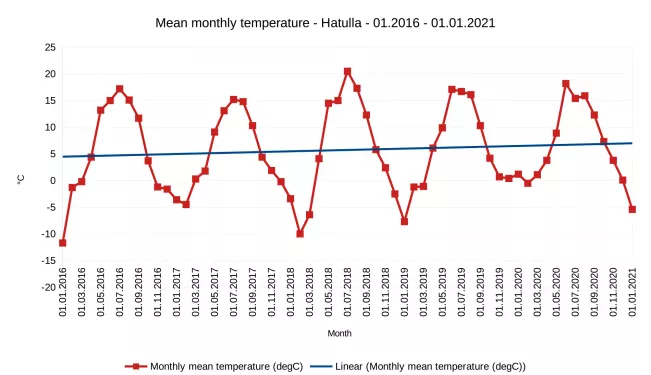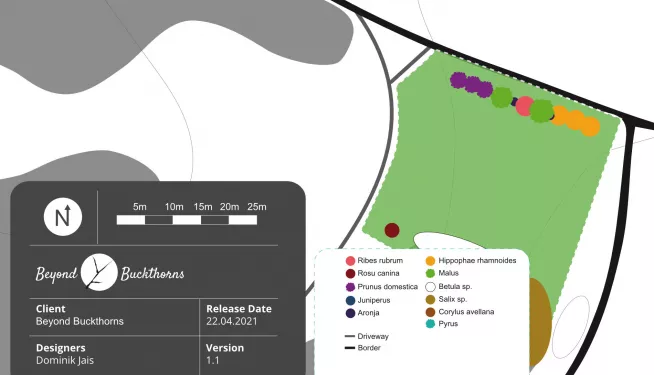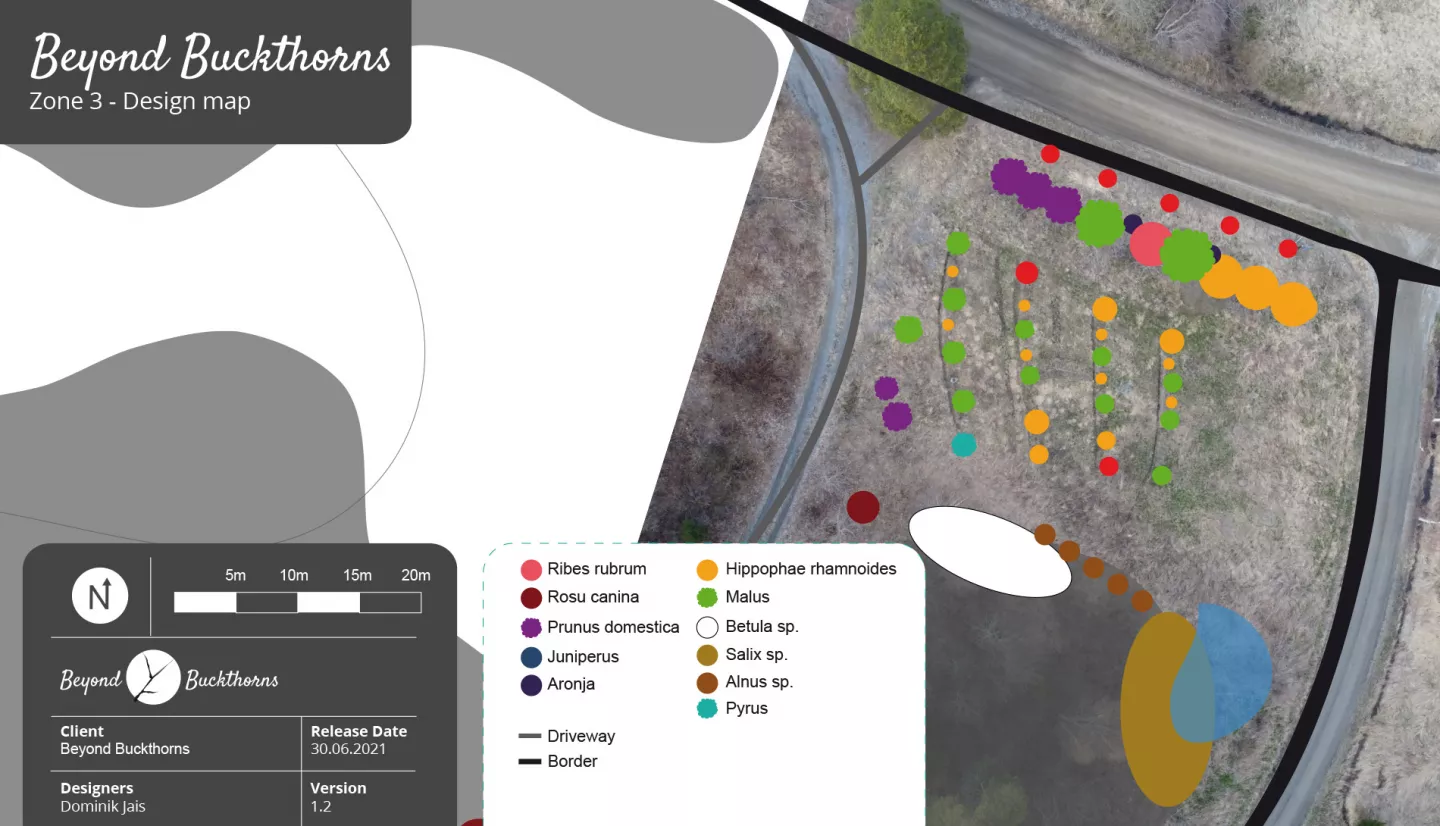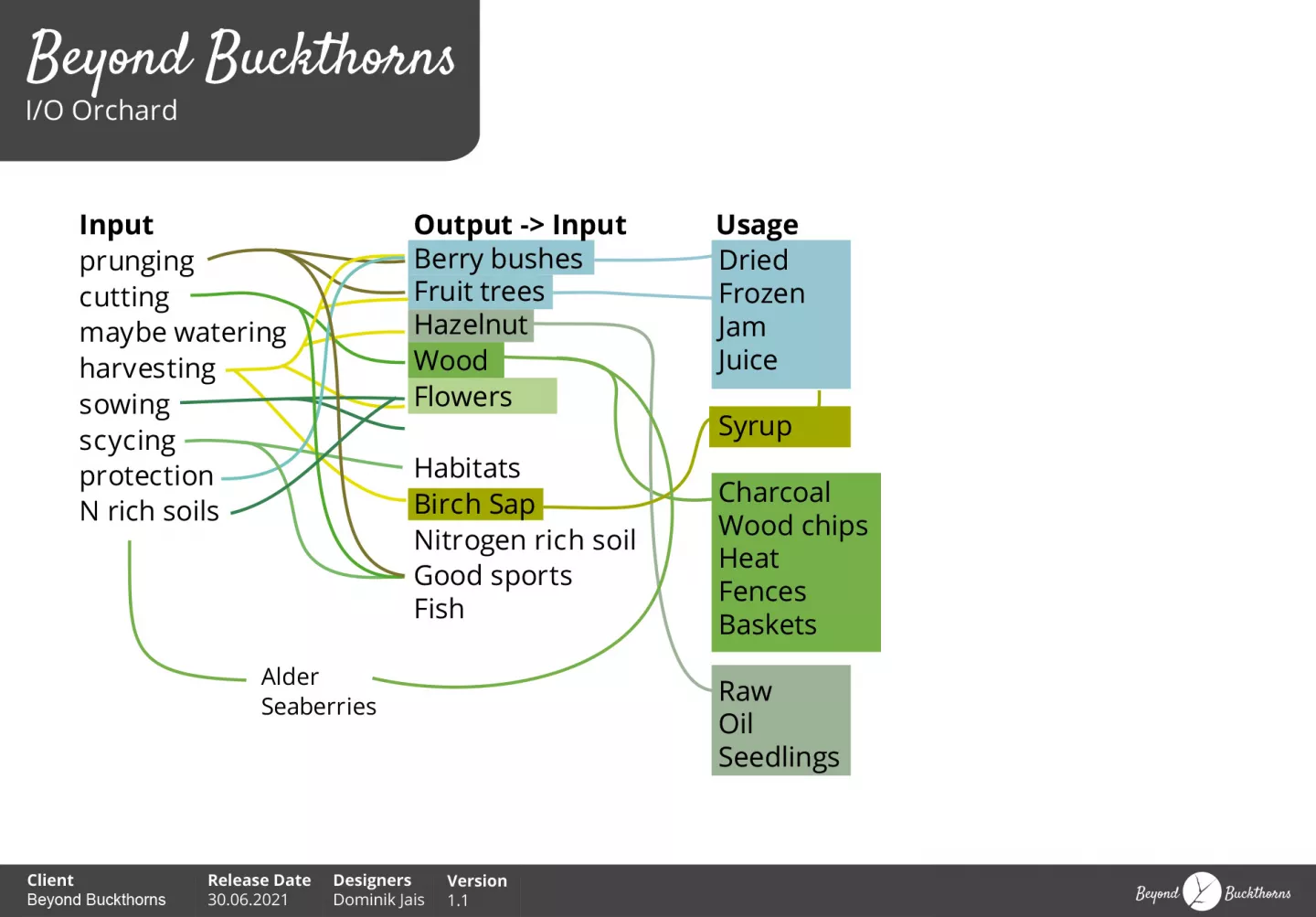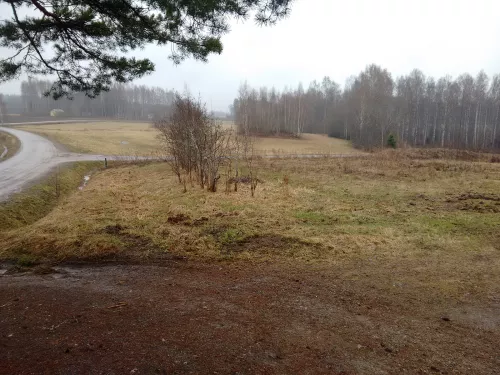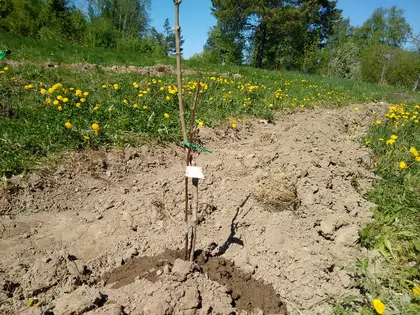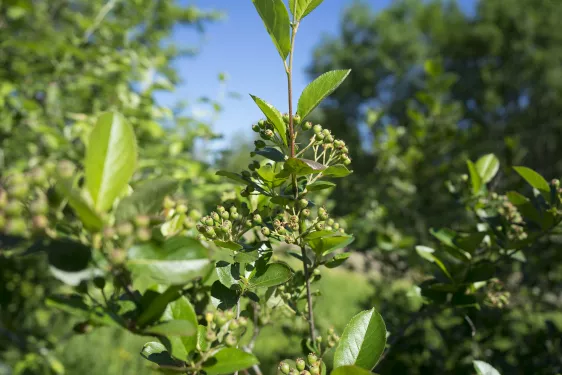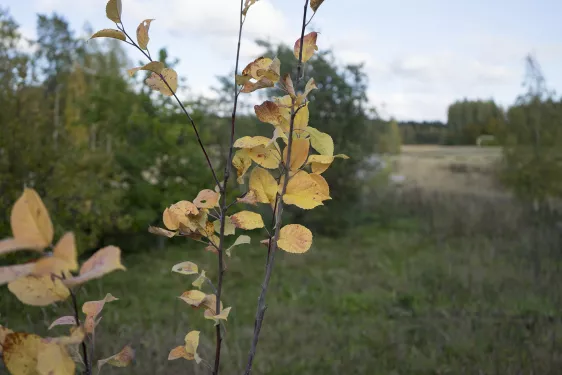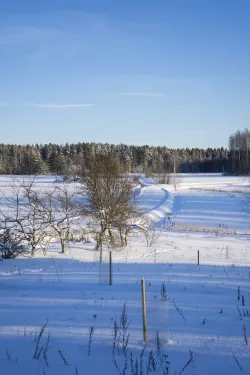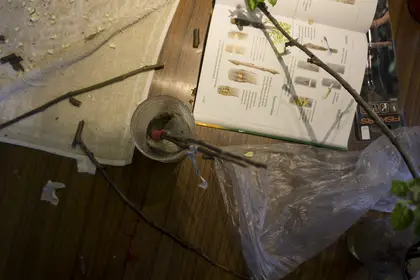Preface
When I traveled to the ecovillage Tamera in Portugal from Faro with the train, I saw the vast areas of devastated landscapes where nothing was growing. When I then arrived in Tamera everything was different. I saw lakes and ponds everywhere in the valley - an abundance of water. And a lot of olive trees planted on contour. Bernd Walter Müller and Jay Abrahams later explained how the system developed by Sepp Holzer works. An interesting presentation.
When Lumia and I moved to Finland in 2016 we started observing right away. We discovered micro climates, areas where edible fungi grew, natural trees nurseries, etc. We also noticed one particular area. An area that somehow seemed out of context to me. It was used for growing vegetables – far away from the house, close to the main road. The whole area is one big gentle slope with a front row of plums, aronia, apples, currents and sea buckthorns down the slope. Delicious fruits and berries!
Summary
The design below describes how I transferred a former annual garden into some type of orchard valuing the existing grassland while using edges to grow trees for multiple usage. In years to come there will be a good yield in fruits and berries. It is my biggest design so far. It uses the SADIMET design process and a lots of different tools. Some of them I used for the first time. Read on if you are interested in permaculture design!
If you don't want to read the full design the video below will give you an idea what Eutopia borealis is about:
Scope
Earth care – create abundance. A lot of apples for eating raw, apple juice and cooking. Sequester carbon. Leave space for nature, wild plants, insects, birds.
People care – a place I and my wife can walk through and be happy but also for family, friends and visitors to enjoy.
Fair share – Sharing apple and berry harvests with family & friends. Sharing this design with the public.
I’m using SADIMET as a design process
Survey
Client interview
Who are the clients?
Lumia and Dominik (my wife and I)
How do the clients feel about current arrangements?
What is already working well?
Access ways, the trees and bushes row towards the road, the willows on the lower point, the birches on the edge to the forest.
What clearly isn’t?
Using the area as an annual garden. It is working for the wildlife but not for us.
What are client’s needs and wants?
What are the current unmet needs (priorities)
The amount of apples is low. It’s enough for some 30 to 40 liters of apple juice. But not enough for apples juice through the year. If we want to store raw apples, have raw apples form August to November our two trees aren’t enough. Enough apples for cider making, eating raw apples from August to November would also be nice.
We like sea berries. Currently we have some bushes. But the amount they produce is not enough for juice making. Some of the bushes are getting old.
Need for wood. The oven is the main source of heat in winter. Finnish winters can be very fluctuating. In the 2020/2021 winter we still had to heat in May. In the 2019/2020 winter it was April. There is need for charcoal and for wood chips.
Another pear or even more pear trees would be nice.
Hammock for recreation.
Space for mother-in-law for an annual garden
Lumia likes to have different habitats on the premises, like meadows, grassland, etc. Lot's of diversity.
What are the client’s values and visions?
We are vegetarians. Involving animals that later get slaughtered is out of the questions. We don’t have the time for keeping cattle, goats, etc. The largest animals possible are chickens.
A vision for the spot would be a nice place to be. A mixture of fruit trees and berry bushes. A place I could put a chair in and read a book or paint a picture, where I can sit in a tree or put a hammock up.
What are their personal limiting factors?
Time and money, ability to lift heavy things
What personal resources do they have?
Time, family, friends, tools, money
What is their financial budget for the design?
400,- €
Length of the time on site / how long they’d like to stay
We live at Beyond Buckthorns since 2016 and we will stay for some years longer
Security of tenure – own or rent?
Own
Site security?
-
Boundaries – ownership and state of repair:
-
Right to way
-
Neighbors activities and relations
Exchange of different goods and services, helping each other
Energy sources and resources / underground utilities
water line, fiber optic cable
Energy or resource leaks
-
Storage
Root cellar
Unused yield
Dandelions, Ground elder,
Animals on site
All wild – deer, rabbits, lynx, raccoon dog
Site history
The area was also used to grow annual crops. Ploughed with the tractor once a year → compacted soil
Locally available resources and services
Masonry, different framers, some organic, welder
Planning issues?
-
Timescale of the design
All should be implemented by spring / summer 2021
Lumias mother
Lumia’s mother, Sirpa, isn’t involved in the holistic management of the estate. She has no saying in the decision making process and also no saying in the design. That’s why I didn’t run a full client interview with her. But since Lumia’s mother has expressed her need for gardening I went with her into the field and she showed me the areas she likes to put an annual garden up. It’s between 20 – 30 m².
Observations
Observation was carried out for about 4 to 5 years during all seasons.
- The whole area is on a south east slope
- During the summer time the soil becomes concrete
- Digging up potatoes out of concrete soil is a very hard job
- Water has to be brought over the “hill” to the annual garden – which is very work intensive
- There are a lot of birches on the edge of the garden towards the forest
- At the lower end of the slope a pond starts to create itself
- Around the “pond” are a lot of willows
- The sea buckthorns do very well, they are up to 6 m tall
- The existing major apple trees do well
- The sea buckthorns produce suckers
- One sea buckthorn is dead
- Plums do well, one tree is dead
- A lot of thistles everywhere
- lots and lots of dandelions, clover
- On the south-west edge to the forest the snow stays longest
- In winter the first 2 meters on the edge to the road is used as a “storage” space for the snow from clearing the driveway
- The lowest part of the area is roughly half a meter above the neighbor’s driveway. A meter below the driveway is a field.
- The dense combination of apple trees, sea buckthorns and aronia works well → lots of apples, lots of aronia, lots of sea berries (I didn’t weigh the harvest but the bushes and tree were full of fruits)
- Test-ditches on contour showed promising snow retention – keeping snow for 2 – 3 weeks longer in the ditch. Making water available during a crucial time in the year.
- Test-ditches also accumulate organic material over time
- Pioneer trees seeding themselves: maple and willow
The picture below is from 2016. It was when the field was still plowed and used to grow vegetables. The second picture is from 2018. Nature had about 2 years to do its work without any big interference.
DAFOR
The definition of the area according to Wikipedia is Grünland (Greenland @ Wikipedia). There is no English translation and definition available. It’s not pasture (there are no animals) and also not a grassland – since it gets scythed 2 times a year. Probably closest to an English version is grassland. There are several terminologies in that area which don’t translate from German to English.
In order to see what is growing I went in and surveyed it using a DAFOR. DAFOR stands for dominant, abundant, frequent, occasional and rare.
| Dominant | Abandant | Frequent | Occasional | Rare |
| German version | ||||
| Wiesen-Kerbel | Huflattich | Brennessel | Strandkamille | Labkraut |
| Giersch | Kriechender Hanhnenfuß | Breitwegerich | Wasser-Braunwurz | |
| Löwenzahn | Venuskamm | Acker-Kratzdistel | ||
| Beifuß | Knäuelgras | Wiesen-Glockenblume | ||
| Gemeine Schafgarbe | Kleine Braunelle | |||
| Weißklee | Vogel-Wicke | |||
| Rotklee | ||||
| Latin version | ||||
| Anthriscus sylvestris | Tussilago farfara | Urtica | Tripleurospermum inodorum | Galium |
| Aegopodium podagraria | Ranunculus repens | Plantago major | Scrophularia | |
| Taraxacum | Scandix pecten-veneris | Cirsium arvense | ||
| Artemisia vulgaris | Dactylis glomerata | Campanula patula L. | ||
| Achillea millefolium | Prunella vulgaris L. | |||
| Trifolium repens | Vicia cracca | |||
| Trifolium pratense |
The findings have been triple-checked with people in different communities and people. Lot’s of thanks to everyone who helped!
Climate data
Climate data was collected from Hattula station. Their data is for free available online. I pulled the data and created diagrams. Interesting is the continuously rising mean temperature and the droughts occurring in March and May. In the years with heavier droughts we have less apples and less sea berries.
Base map
The to design area is roughly about 35m x 35m, which is a total of 1225m². The north-eastern and south-eastern border are roads. On north-west top is our driveway. As you can see the whole area is on a slope and also the area in white and gray is on a slope. The white and gray area is a mixture of coppicing area, new and old forest. There are a lot of willows, alder, maple, pines, spruce, etc. On the south west side is a mixed continuous cut forest with spruce, maple, birch, and pine.
Zones
For the whole Beyond Buckthorns site design we surveyed the site for zones and then put them on our base map. The field in question is in zone 3.
The area is about 130 meters from the house and was used to grow potatoes, pumpkins, peas and beans. We abandoned it as vegetable growing area after the 2016 growing season since it is too far away and the water situation can be difficult.
Sectors
A sector analysis was done by Lumia and me some time ago for the whole estate. The wildlife is basically all over the place. Deer or rabbits come from any direction and travel through it. Drone photos taken during winter, when you can see their paths in the snow, confirmed our initial sector analysis regarding the wildlife. See the findings below:
There is no protection from the harsh northern winds in winter. The summer sun reaches the spot while the winter sun doesn’t. That’s why at the edge between the forest, which is higher in the landscape, and the field, which is lower, the snow stays long(est). The winter sun can’t reach the basin. Since the whole area is on a slope and the summer sun is pretty high at 61°N the sun can’t be blocked by large trees in the south-west.
Budget
It is unclear yet on how much money is needed to get things done. Since I don’t have a lot of money 400,- € is the maximum.
Limits & Helps
| Limits | Helps |
| internal | internal |
| money | tools |
| time | knowledge |
| knowledge | books |
| amount of time for learning | external |
| external | web |
| tutors time | community |
| availability of tools | family, friends |
| tractor | |
Furrows – ditches and berms
In 2018 I had a conversation with a leading Finnish permaculturist after which I first used an a-frame to get the contour lines of the field and then drove with the tractor and the plow to plow a furrow on the established contour line. Plowing on contour results in a ditch and a berm. As the ditches are deeper than the rest of the field more snow will accumulate there and melting takes longer. Therefore more water should / is available in spring. Something similar is described in the “Designers manual” page 125.
The berms are visible in the landscape. I can easily orientate myself. Instead of looking for plantings in a field of thousands of natural plants I just walk along the berm and find everything I planted.
Over the years I had several discussions with different members of the Nordic permaculture community, especially Andreas Jonsson from Sweden and Dan McTiernan from UK – who have furrows, ditches or swales on their premises. The conses is: the system will always accumulate organic matter, stop runoffs and keep snow. It’s a multiple functions per element based strategy that even works in the Nordic countries.
Analysis
Plants and what they mean or indicate
| Place | Indication | Animals | |
| Dominant | |||
| Anthriscus sylvestris | N | ||
| Aegopodium podagraria | on humus and loam soils | ||
| Taraxacum | Bees love it | ||
| Artemisia vulgaris | on nutrient rich soils | ||
| Achillea millefolium | pioneer, soil fastener | N | |
| Abundant | |||
| Tussilago farfara | warm, penetrable soils, pioneer | water-logging | |
| Ranunculus repens | pioneer | water | |
| Scandix pecten-veneris | on clay / loam soils | ||
| Dactylis Dactylis glomerata | nutrient rich, especially N | ||
| Frequent | |||
| Urtica | N | Butterfly love it | |
| Occasional | |||
| Tripleurospermum inodorum | 120 cm deep roots, mostly on rich soils | nutrient rich soils | |
| Plantago major | very robust, | ||
| Cirsium arvense | at dry places but also in wet shaded spots | Butterfly love it | |
| Rare | |||
| Galium | was used as an acidulant for cheese making | ||
| Scrophularia | likes more or less wet places |
According to different plants I have a nutrient rich soil, especially rich in Nitrogen. On the lower part of the slope water-logging is indicated. The information about the plants was derived from Wikipedia.
Contour and orientation
The image below shows contour lines coming from digital image processing using several different pieces of software. The entire high difference between the top and the bottom is about 3.2 meters. Each contour line is about 15 cm apart. Unfortunately this image was taken while there was still partially snow. Therefore the upper side down to the middle is less accurate. It still gives an idea about the slope and the basin that leads toward the lowest point.
From the contour profile and multiple runs of drone imagery I can determined the height difference from the top of the area to the lowest point at about 3.2 meters. The area is facing south east. Due to the sun height in Finland from spring to summer there will be a enough sun from April to September to be able to grow apples. The height difference of 3.2 meter and a field of a length of 35 meter makes it a 5.73° slope. Is very gentle. The lowest point in the area is actually on the neighbors field – more than 2 meters below my field. Additionally there are no blocking objects, therefore the chances of frost are minimal. From my perspective the slope is suited for fruit growing.
Calculation of the amount of apple trees
The following calculation assumes that we get 30 kg of apples per tree. The calculations are conservatively on the lower side of what might be or is possible.
| Trees for own juice | |||
| Apple juice in liter per year (derived from 2,5 liter / week) | Apples needed | Yield per Tree (kg) | Number of trees for juice |
| 130 | 200 | 30 | 6 |
| Trees for juice for family & friends | |||
| 40 | 62 | 30 | 2 |
| Cider making | |||
| 20 | 31 | 30 | 1 |
| Trees for direct eating summer (Borgovskoje – August) | |||
| Weight of apple (g) | Yield per Tree (g) | Apple per tree | |
| 150 | 40000 | 266,67 | 1 |
| Trees for direct eating autumn (Railamo – September) | |||
| Weight of apple (g) | Yield per Tree (g) | Apple per tree | |
| 150 | 40000 | 266,67 | 1 |
| Trees for direct eating autumn (Antonovka – Oktober) | |||
| Weight of apple (g) | Yield per Tree (g) | Apple per tree | |
| 150 | 40000 | 266,67 | 1 |
| Total | 12 |
Literature of orchard design describes the amount of planted trees between 1200 – 2400 ha-1, depending on the tree. The area to design is ~ 0,1 ha. That makes it a maximum of 120 trees. With a need for 12 trees we are on the low side with what practically could be possible in an intensive system.
Nutrient demand of apple trees
Since trees like apples have a nutrient demand I checked those in different sources.
In literature of orchard design the demand of apple trees is given in kg / ha. They calculate the total amount needed by subtracting the amount of N containing material that returns to the soil, like leaves and wood cuttings (chipped) from what goes into growth – wood & apples. The following numbers are given in kg ha-1.
| P | K | Ca | Mg | N | |
| 1 ha | 14,4 | 114,5 | 135,5 | 20,6 | 89,5 |
| 1/10ha | 1,44 | 11,45 | 13,55 | 2,06 | 8,95 |
| 1/10/10 | 0,144 | 1,145 | 1,355 | 0,206 | 0,895 |
| 1 tree | 0,01 | 0,08 | 0,09 | 0,01 | 0,06 |
0,06 kg = 60 g N / tree / year.
Other sources described the N need in lb N / tree with 0.75 lb N – which is 0,34 kg N / mature tree / year. In younger trees the need for N is even less.
Martin Crawford in his book “Creating a forest garden” calculates the demand of N / year for an apple tree by first calculating the canopy area and then multiplying it by constant of 8 g N / m². The formula is A x nutrient demand constant. In my case, with a canopy of 7 m2, this would result in 56 g N / year, which is kind of the same as what is written in the orchard design book.
For Potassium (K) the constant given by Crawford is 10g / m2 for what he calls heavy croppers. In orchard literature it is described with 80 g / tree. Again his numbers are kind of the same.
Sea Buckthorns
From the client interview it was clear that sea buckthorns should be in the design.
Sea buckthorns is categorized as an actionorhizal plant. Nitrogen fixation happens with the actionomycetes Frankia. It’s forming nodals on the roots of the plant. Literature describes the amount of N a 1 ha plantation of sea buckthorns can fix with 200 kg N / ha. Other literature stated lower numbers with 179 kg N / ha. But the ballpark kind of is the same. The number of plant density is described at about 1500 plants / ha.
| Kg N / ha | Bush / ha | Kg N / bush |
| 200 | 1500 | 0,13 |
The 0,13 kg N / bush sea buckthorns is already 1/3 of what a major tree needs.
Crawford uses a different system again. He sets the constant at 10g N / m². A sea buckthorn with a size of 5 m has a diameter of 4m resulting in a canopy area of 12 m². That would give me 120 g N / year. Which is the same described in scientific research and derived from calculation.
Wood
The order of needs
- Wood chips
- Charcoal
- Firewood
Wood chips
There is also demand on wood coming from different areas - from the annual garden to the greenhouse to the multi layer garden. What is needed is mulch in form of wood chips. Since years I produce the wood chips myself using an electric wood chipper. It takes more time than a diesel driven but I can use the electricity form the solar panels on a sunny day to get it done carbon neutrally.
Charcoal
The KonTiki kiln will be ready sooner than later. Charcoal production will then be on an entire different level than it currently is. According to a master thesis form the University of Technology Lahti, Finland, willow is the best raw material for biochar production due to its great pore structure.
I have effluent from the biogas plant that can be used to charge the biochar.
Firewood
Firewood need is difficult to estimate due to the very fluctuating winters in Finland. At Beyond Buckthorns Lumia manages the firewood and her take is: “You should have more firewood than needed”. We usually have about a 3 years storage of firewood. A big portion comes from us cleaning up logged forests of friends. Therefore we are used to “light” firewood. But we also have our forest in which mainly pine, spruce, maple, birch, oak, willow and alder grow.
Average trees height
In order to make sure that not too high growing trees get selected I checked the height of native trees in Finland. The numbers below are an average from different sources and drone flights.
| Tree | meter |
| Maple | 30 |
| Birch | 30 |
| Spruce | 30 |
| Pine | 40 |
| Willow | 8 |
| Aspen | 20 |
| Alder | 8 |
Nitrogen fixing trees / shrubs
Sea Buckthorns
Already described above
Willows
According to different publications and research willows can fix nitrogen. A lot of different bacteria, e.g. Proteobacteria, Actinobacteria and Bacteroidetes are living in the stem tissue. Among those endophytic bacteria there a lot of diazotropics.
The postulated amount of fixed nitrogen by willows is between 27 – 98 kg N / ha / y.
Alder
Alder fixes nitrogen like Sea Buckthorns, by a symbiotic relationship with Frankia. According to Wikipedia it fixes about 130 to 320 kg N / ha.
Flow map
Every other day during the week Lumia or I walk to the street to get our mail. So we walk the path from the house to the road about 3, sometimes 4 times a week. The path comes across the area I want to design. During summer time I also walk around the forest and the existing row of trees and berry bushes about once or even twice a week.
Soil samples
In order to determine the soil texture I dug up some samples and put them in jars. It is the standard DIY soil texture analysis where the results can be measured and then checked in the soil texture pyramid. https://www.fs.fed.us/t-d/pubs/htmlpubs/htm06232815/page04.htm
According to my findings in the soil pyramid it is a loam or silt loam. The result reflects my observation: easy to transform when wet and concrete when dry.
In Finland the soil in rural areas is generally acidic. There are also pretty pure blue clay veins passing through the area.
Function, System, Elements
Functions coming from the client interview and the needs that derived from that.
| Function | System | Elements |
| More food, especially apples and sea-berries | Apple tree area | Trees |
| Tree Wildlife protection | ||
| Nitrogen fixers | ||
| Nutrient supply | ||
| Multi layer orchard | Tree Wildlife protection | |
| Nutrient supply | ||
| Nitrogen fixers | ||
| Ground cover plant | ||
| Berry bushes | ||
| Climbers | ||
| Egg mobile | Egg mobile | |
| Chicken | ||
| Pond | Pond | |
| Water plants | ||
| Fish | ||
| More wood | Coppicing | Willows |
| Alder | ||
| Forest | multiple types of trees | |
| Nitrogen fixation | Multiple elements for important functions | Sea berries |
| Willows | ||
| Alder | ||
| Clover | ||
| Garden for mother in law | Garden area | Space |
| Recreation | Archery area | Targets |
| Pond | Pond for swimming | |
| Relaxation | Hammock | |
| Air Chair | ||
| Open water | Pond | Pond |
| Water plants | ||
| Ditch on contour for snow retention | Ditch and berm | |
| Trees and bushes to hold the berm |
Lumias mother
From what Sirpa showed me I don’t see any bigger implications in the process on the design itself. Her demand on space, some 20 m² is pretty low and can be fitted in any niche in an area of over 1000 m².
Principles
- Observe & Interact → done in the observation phase. Now its time to do something about it.
- Catch & Store Energy→ grow produce for consumption, apples, pears, plums, sea-berries, raspberries, etc.
- Obtain a yield → gaining experience with grafting, gain knowledge on Finnish fruit tree varieties and root stocks. Experiment with different bushes and trees. Let my mother in law plant all kinds of plants & flowers.
- Apply Self regulation & accept feedback → the wildlife is causing damage and precautions need to be taken. Over the years different plants grew.
- Use & Value Renewable Resources & Services → scions from apple trees for grafting, cuttings, layers and suckers from different berry bushes
- Produce no waste → it well take some time until the apple trees will produce. I’ll have to use the time to get the apple juice making going. Cuttings from the apple trees as natural fences for the rabbits → need to be of certain size before cuttings become substantial.
- Design from patterns to details → reminds me always to start from the big picture when designing.
- Integrate rather than segregate→ Apple trees and berry bushes on contour. It feels like they belong there.
- Use slow & small solutions → grafting apple trees instead of buying 3 to 5 year old. Using cuttings from own existing berry bushes instead of buying. Let other trees grow if they want to grow and then find a way how to tweak the design.
- Use & Value Diversity → different varieties of trees, bushes - local, from different suppliers. Nature itself is already diverse – add here and there and value what you have!
- Use edges & value the marginal → The edge to the forest is full of willows and some birches. People who understand that not everything needs to be a food forest are rare. So is the people who understand ditches and perms in Nordic context.
- Creatively Use & respond to change → Action learning is also about failing and learning from that.
Mindmap
I think it is well suited here since there were a lot of information processed and a clearer picture can be formed by having a visual aid of all the facts. Check the documents section for a PDF.
Design
Walking from the driveway down to the lowest point is always nice. The view is beautiful, especially in summer. It is a little louder since it is closer to the bigger road, but still quiet enough to just lay there in the summer grass and listen to the insects and birds.
Ideas
The area is for me too far away for a food forest. I have already 3 food forest areas on the premises and I don’t need another one. I’m not interested in selling any produce and with a food forest design I would definitely produce more than I could handle which then will result in work.
I’m also not interested in a standard orchard. The German term of Streuobstwiese is probably better suited. But since there are more needs I can’t just use the existing greenland / grassland and transfer it into an orchard.
It is pretty clear that I’d like to have more fruit trees and berries. I already have two ditches and berms on contour for testing. 2 or 3 more will work.
Besides the fruit trees I’d like to have a coppicing line parallel to the edge of the forest, extending the forest edge. I will get a lot of wood for wood chips, charcoal and perhaps even for heating.
On the berm will be a variety of trees and bushes, mainly apple and sea buckthorn. Some are bought, some are grafted, some are propagated, etc. I use & value diversity.
Between the swales is space for multiple functions per element. It will be a space for my mother in law’s garden activities. It could also be a space for an egg mobile, or let just nature take its way and go for a small and slow solution, while working with nature – keep the greenland and cater to Lumias need for diversity. I want in another design test corn and barley in the experiment space. Holistic beer brewing might be fun. In any way it is everything gardens.
And the not yet used space is also something that can be developed later, something I’m yet not aware of. Leaving space for things to happen. Waiting for change which I can respond to.
One important prerequisite is: I’d like to be able to get with the tractor in and out. And I need to think of a space where all the snow from clearing the driveway goes.
Everything is in alignment with the ethics. I create abundance and sequester carbon. It will be for me and my family and the surplus will be shared.
Choosing the trees
Willow
They are a good combination in fast growing biomass, not too big, suitable for char-making in a KonTiki and also suitable for wood chip making. They come with multiple functions per element. Since willows are fast growing, 1 to 2m per year, I expect large amounts of leaf litter which will increase the humus content of the soil.
Alder
As described they fix nitrogen. Can be coppicied and don’t grow very high. They are ideal because they don’t create any shade since they are lower than the forest trees.
Birch
Besides that there will be birch for sap making and fire wood. The birches will be on the west edge of the forest. They are already there and spread.
Calculating nutrients
For an entire site that is full of plants indicating a lot of Nitrogen in the soil Nitrogen fixing shouldn’t be a topic. By adding sea buckthorns I will be probably on the safe side. But with high yielding trees situation might change. The calculation below is based on numbers given in Martin Crawford’s book.
| Annual requirement | |||||||||
| N requirement in g / m² year | K requirements in g / year | ||||||||
| Amount | What | Full grown canopy area in m² | Total canopy area in m² | Moderate croppers | Heavy Croppers | Annual Vegetable | Moderate cropper | Heavy Croppers | Annual Vegetables |
| 3 | 8 | 28 | 3 | 10 | 37 | ||||
| 12 | Apple | 7,065 | 84,78 | 678,24 | 847,8 | ||||
| 1 | Pear | 7,065 | 7,065 | 56,52 | 70,65 | ||||
| 2 | Plums | 14,13 | 28,26 | 226,08 | 282,6 | ||||
| 2 | Red currants | 0,8 | 1,6 | 12,8 | 16 | ||||
| 14 | Sea Buckthorns | 4,71 | 65,94 | 659,4 | |||||
| Total N | 973,64 | Total K | 1876,45 | ||||||
| N-Fixers | |||||
| N fixation in g / m² year | |||||
| Amount | What | m² | Total m² | Full light | Partial light |
| 10 | 5 | ||||
| 14 | Sea Buckthorns | 7,065 | 98,91 | 989,1 | |
| 8 | Alder | 7,065 | 56,52 | 565,2 | |
| Willows | 7,065 | 0 | 0 | ||
| Total N | 1554,3 | ||||
| Annual contribution | ||||||||
| Yearly | Suffix | Source | Amount N | Suffix | Amount K | Suffix | N g / year | K g / year |
| N-Fixer in Full light | 10 | G / m² | 1554,3 | |||||
| N-Fixer in Half light | 5 | G / m² | ||||||
| 180 | pees | Human Urine | 5,6 | G / pee | 7 | G / pee | 1008 | 1260 |
| 24 | plants | Comfrey Single Cut | 0,5 | G / cut | 10 | G / cut | 240 | |
| 50000 | L | Biogas slurry | 1,60 % | 1,00 % | 800 | 500 | ||
| Total | 3362,3 | 2000 | ||||||
The limiting factor is potassium (K). But we have to understand that is is a projection into years to come. Young trees don’t need that much. And currently most of the N can be provided by the clover growing in the area. Biogas slurry and pee should be no problem. Can even be mixed before delivery. The peeing time is limited to the month without snow. Both could be put into charcoal and then the charcoal gets delivered. I’m not decided yet. I will test different methods over the years.
There is one thing that is extremely difficult to calculate: the scythed areas. There is a lot of green material that acts as mulch over the entire area. This will be another source of minerals. See the calculations for just 2000 dandelions below:
| Dandelion | K | Ca | ||
| in 100 | g | 397 | 187 | mg |
| average 65 | g | 258,05 | 121,55 | mg |
| 2000 | plants | 516100 | 243100 | mg |
| Total | 516,1 | 243,1 | g / year |
There is one thing that is extremely difficult to calculate: the scythed areas. There is a lot of green material that acts as mulch over the entire area. This will be another source of minerals. See the calculations for just 2000 dandelions below:The limiting factor is potassium (K). But we have to understand that is is a projection into years to come. Young trees don’t need that much. And currently most of the N can be provided by the clover growing in the area. Biogas slurry and pee should be no problem. Can even be mixed before delivery. The peeing time is limited to the month without snow. Pee and Biogas slurry could be put into charcoal and then the charcoal gets delivered. I’m not decided yet. I will test different methods over the years.
According to permies.com https://permies.com/t/19885/list-dynamic-accumulators-minerals-accumulate Dandelions are the ultimate dynamic accumulator – even better than comfrey. I have lots and lots of them.
Placement of elements
Compiling all the ideas looks little like this:
Design map
I also included a cherry tree row besides the street. They are wild cherry trees from cherry seeds. Can be grafted later. It should look fantastic when they are blooming. The cherry tree line also has another function: they protect the sea buckthorns from unwanted harvest theft. We once had people ripping entire branches from the bush – by that damaging the bush.
At the lowest point I included a small pond. The plant in abundance there is Tussilago farfara, which indicates water-logging. It seems like the best suited place, every year, after snow has melted, there is already a small pond for some weeks.
I had to imagine how it will look like once the trees are 10 or 20 years old, and I think that picture looks amazing. It’s something people driving by might stop for a picture, even go into, pick an apple. I also like the place when it is 200 years old.
The Antonovka root is one of the common apple root-stocks in Finland. It grows into a large tree. The recommended planting distance is 4 meters. I deliberately planted them closer, 3 meters, so that they grow into each other (remember the photo of the guild of apples and sea buckthorn). Besides the Antonovka there are other apple trees – autumn and winter apples. The idea is to have apples through the seasons.
The overhead of what is not eaten during the year goes into purée making, drying and storage and if there is still surplus the apples become energy food for Jean Luc (link here).
I put the plums up on top since it is the line that might get damaged the most from the snow cleaning. Since I have a lot of plums it doesn’t matter that much if they get damaged.
Every apple tree comes with 2 comfrey plants and an abundance of dandelions and clover.
Implementation
| Implementation list |
| Build an a-frame |
| Mark 2 lines with the a-frame |
| drive the tractor with plow along the marked lines |
| observe if the swales are working |
| if working mark 2 more lines with the a-frame |
| drive the tractor with plow along the marked lines |
| calculate the number of trees possible |
| buy the calculated number of trees / roots |
| cut existing apple and pear trees |
| graft apple and pear trees |
| transplant plum trees |
| layer gooseberry and currants |
| plant cuttings of currants into pots |
| buy sea buckthorns |
| plant trees, bushes |
| transplant cutting and layered plants |
| put wire mesh around the fruit trees |
| Cut existing willow branches |
| Plant branches |
| Research excavator rental |
| Rent excavator and dig pond |
| Research water plants, get them and plant |
| Get fish and release into pond |
Maintenance
| Maintenance plan orchard | ||||||||||||
| Jan | Feb | Mar | Apr | May | Jun | Jul | Aug | Sep | Oct | Nov | Dec | |
| Prune trees | x | |||||||||||
| Cut trees | x | x | ||||||||||
| prune bushes | x | |||||||||||
| check for animal damage | x | x | ||||||||||
| check growth | x | x | x | x | x | |||||||
| harvest | x | x | x | x | x | |||||||
| Bring nutrients | x | x | x | x | ||||||||
| Scythe | x | x |
Evaluation
This one is difficult yet to evaluate. Problem is that it is much too early. The berms are much richer in vegetation than the rest of the area. I can see the color difference. It is a far darker green. In the area between the swales, trees have started to grow, for example willows and maple. The natural succession has done and is doing a great job and all I do is watch and cut the mow from time to time. When I look at the difference between using it for gardening and just letting it be – I prefer the greenland.
Input / Output results
Trees
Most of the initial grafting didn’t work. My success rate is 1/3. I’m still learning. But probably should have practiced with willows or other in abundantly available trees. Besides my grafting mistakes the apple, pear, plum and cherry trees are doing well. They are growing steadily. I guess that grafting errors came from multiple things. First of all my technique wasn’t the best. I used a single sloping cut. Another cutting technique which gives more connection between the root and the scion might be better. I also put them straight into the soil. According to some websites the newly grafted trees are not that winter hardy. While some of them had leaves in September, the scions were dead in the spring of the following year. But, nearly all the root-stocks are fine. Therefore I can graft again – but first practice on trees that I have in abundance.
Multi usage
My mother in law is using the space between the berms to garden. I don’t tell her what to do – she just has to keep an eye on the planted trees. She told me over a coffee that physical work is important to her and she enjoys it. What more can I do than let her do what she enjoys?
Budget
| What | Price | Amount | Sum |
| Apple Root-stocks | 3 | 10 | 30 |
| Apple trees | 3 | 12 | 36 |
| Pear tree | 1 | 18 | 18 |
| Sea Buckthorns | 12 | 3 | 36 |
| Hazelnuts | 5 | 3 | 15 |
| Wooden posts | 2,5 | 20 | 50 |
| Metal Mash | 1 | 50 | 50 |
| Tutoring costs | 6 | 35 | 210 |
| Total | 445,- € |
Since the apple trees where mainly root-stocks I saved some money.
I put the cots for tutoring this time in. I had to overhaul the first iteration of the design. This brought me over my time limit and put the design over budget.
I probably could have saved money creating the wooden posts by myself. But it would have taken me hours to get it done. Also the metal mash might not been the best solution to protect the apple trees from the rabbits. If I would have rented the excavator I would be far over budget.
What I couldn’t do and why
I couldn’t get the pond done. As I explained I wanted fish and this means certain depth of the pond. I couldn’t dig that with a shovel. Since I have several areas on the site for which I need a mini excavator I postponed the implementation of the pond until the other designs are in its implementation stage. A mini excavator would cost me 150 € / day. I thought it might be far better money wise to get everything done in one day instead of renting it every time I need it for one design.
Tweaks
Since the grafting didn’t work I decided to let the base just grow until I’m more experienced with grafting and then graft them again with scions from major trees. I think I will transplant more cherry trees into the front line als a rose hip.
Two trees in the first (top) and last row where planted to close to each other. I will move them to another spot.
Lumia sowed a lot of different flowers on the berm.
There were some trees that weren’t surrounded by clover. I transplanted some of it.
Over the years I have to see what kind of insects and birds are in the greenland though that we can adapt the mowing time to their needs.
Reflection
General
I ran a presentation about the PermaPuheet and this design. When I got asked about guilds for my apple trees I answered that I didn’t think of any other than comfrey. I explained that there are so many wild plants, especially an abundance of dandelions, that specific guilds in zone 3, 120 meters from the house, didn’t make any sense to me. The pioneer plants, like maple and rubus idaeus are already coming in. In 200 years, if no one takes care of it, the whole area will be part of the forest.
The forest garden concept has become the go-to-solution everyone is interested in, even here in Finland. Put it like this: “If all you have is a hammer everything looks like a nail”. Only food forest gets attention, and food forest courses get participants while normal permaculture courses are of no interest and need heavy advertisement. Over this design I started to feel so guilt tripped in not doing what everyone else does.
When I presented my concept I got that people weren’t satisfied as it was not a food forest. But not everything needs to be one. The term forest garden or food forest is a misnomer anyway. A forest has at least a size of 0.5 ha closed canopy to be actually called forest. Most food forests are smaller than 0,05 ha. Have you ever been invited to a 4 m² food forest? No? That’s fun. Looking at 1 birch, 2 currents, 2 comfrey, some strawberries and different herbs. The concept is there and its good for teaching but it is a disgrace to the term forest and how mighty a forest is. I call my 3 food forests now multi layer gardens.
To come back to my initial point. What if everything is a food forest? Then there will be no more space for the wild plants. But I like them. And I think that they deserve their space. I was once told by a well known permaculture gardener that she designs also for beauty, because this is healing too. Humans tend to see artificially created beauty as beauty. There is no better beauty than nature without (big) human interventions. Laying in the grass, listening to all the insects. The birds nesting in the high grass. Ordonata flying around. Coccinellidae climbing over my fingers. The smell of fresh clover. All this natural beauty that nature constantly creates. Nature is a far better designer than I ever will be.
From that it should be clear that the outcome, an orchard with ditches and berms and greenland in between, is far more desirable than a multi layer garden. In 10 years time I expect the apple trees to create shade and me being able to get a hammock up. From other areas with mature pear and apple trees I couldn’t see any significant change in the surrounding grassland. (perhaps if I run a DAFOR I see it more detailed) Those three strategies, berm & ditch, grassland and orchard, should work hand in hand. I’m very happy to not have included the willow / alder trees in rows but put them on the edge of the forest. They will not heavily interfere with the grassland orchard – keeping it in balance as it is.
About the process
SADIMET is one of my favorite processes. It is simple enough and not to heavy on the designer. I prefer my own processes since from my point of view most design processes don’t reflect reality. But that’s another long topic. SADIMET is good enough for now.
The client interview, even if designing for myself, made the difference. It put clarity up on the table and separated the role of designer and client. From there it was much easier than without. If I'm designing for myself I will always run a shorter version of it.
I did a comparison of different designs (mine and others) and their tool chain. The tool chain is the sequence of tools used in a design process. The larger the design the more tools come to play. For this one I did for the first time a DAFOR and I now have a far better connection with the land. I kind of understand better what is going on and it actually is fun. I think it is one of the essential tools in land based design when larger areas get designed.
I was using all kinds of different software. Creating the maps, reusing them, scale them, etc. In the beginning I draw with pen & paper and my pocket stencil template, when size and ratio doesn’t matter that much. But once precision kicks in I really like my graphic design suite, the 3d mash modeler, the CAD software, etc. I think for larger designs this becomes essential.
Besides the software suits for creating maps, illustrations or editing photos all the different project management tools, software and methods were helpful. It’s beyond the scope of this design to describe them here.
Aerial images from a drone were very helpful. I used them before and I find them far better for areas for which I can’t get any (good) satellite images.
What was helpful in this design was consultation from different permaculture practitioners mentioned earlier. Talking with people who have ditches and berms, asking them for recommendations, gave me a better picture of the topic.
From the scope
Earth care – create abundance. A lot of apples for eating raw, apple juice and cooking. Sequester carbon. 12 trees will be enough apples. It will be abundant for us. The trees, and bushes, all of them, will sequester a lot of carbon – the willows / alder and the creation of charcoal from them especially. I have left space for nature, wild plants, insects, birds.
People care – a place I and my wife can walk through and be happy but also for family, friends and visitors to enjoy. I already enjoy it. Lumia enjoys it, and her mother as well. Let’s see what visitors say in the future – once the trees have matured.
Fair share – Sharing apple and berry harvests with family & friends. Sharing this design with the public. This is already happening with the harvest of existing trees and bushes.
I’m looking forward to see the trees grow over years to come. I’ll now get my bow out and practice a little.
Accreditation criteria
Demonstrating design skills
- Climate data
- Client interview
- DAFOR
- Base map
- Function, System, Elements
- SADIMET
- Contour profile
- Zones
- Sectors
- Budget
- Limits and Helps
- Flow map
- Soil samples & Soil diagram
- Mind map
- Design Map
- Implementation plan
- Maintenance plan
- Input / Output
Applying permaculture in my own life
This design made me realize that I have to learn more about wild plants. It helped me to connect with nature, reading about the wild plants growing, their benefits. I also discovered a new online community. It also helped me to connect more with Sirpa, my mother in law. She helped me to identify some of the plants.
During the design I realized again that there is no perfect design and never will be. It is about what I can do within the limits defined and I hopefully come as close to the scope (vision) as I can. And its about the needs defined by myself. If I can be more on the regenerative site of things - fine.
The most difficult part for me in this design was something not obvious. It took me some time to overcome a mental challenge. I was close to just drop the diploma on the last design. I’m not going to explain why that happened and how I overcome it. In the end people care helped. I’m very thankful to Dan and my wife Lumia.
Learning from and developing your permaculture practice
From identifying indicator plants to calculating nutrient demand and supply to tree selection based on needs – I learned a lot and it was fun.
When a friend pointed me to guilds and why I’m not using guilds in the orchard I got back to the designers manual. I actually never have seen an interaction matrix during the whole diploma process, which is described at the designers manual page 63, by anyone who is talking about guilds. You can search Google for either “interaction matrix” or “co-action matrix” and you will find nothing plant related. I was surprised that many people in the permaculture community are talking about guilds but actually don’t know how they should prove or document their guilds.
What I also learned: the map is (definitely) not the territory, which is a quote from Alfred Korzybski. You can do your best to describe everything to the tutor and the public and you still miss something. It is not possible to catch all and every detail. The diploma is not a PhD thesis, its a diploma.
Costs for tutoring are costs for professional consultation and it needs to be in the budget. Something I forgot to calculate or anticipate in my previous designs.
Applying permaculture to my work and projects
Within Holmgren’s domain this is in “Land and nature stewardship”. I’m not sure if I like that term of that domain because humans are incapable of nature stewardship, we don’t understand nature and we probably never will. And: nature takes pretty good care of herself – without humans. In my humble opinion the whole domains make no sense. Permaculture is everywhere not just in some specific domains. The domains basically limit permaculture design. Just a thought after 10 designs. What I’m saying is: not everything what got developed over the last decades is scientifically right and should be used within permaculture design.
My works and project are bound to the permaculture ethics, and its principles. I use or develop my own strategies and techniques and use those that have been established and proven. I take the luxury of time to think about well established strategies and techniques and not just use them because I was told to do so. I have a lot of tools in my arsenal and I develop my own. I adapt tools and methods from other communities if I find them useful. I reference other peoples works correctly and make sure that I don’t use copyrighted material. If I collaborate or get ideas and help from others I name them.
Documents
| Liite | Koko |
|---|---|
| Mind Map | 84.05 KB |
| Design Map | 494.17 KB |
| Ditch / Altitude profile | 451.96 KB |
| Nutrient calculations | 30.88 KB |






